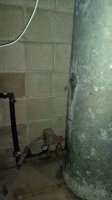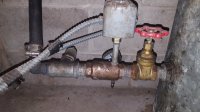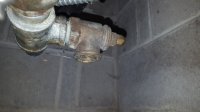pyro2
New Member
Hi All,
What would be the equivalent size Well-X-Trol tank to my current 80 gallon galvanized tank? Its currently 50/70 psi pressure. I need to replace my galvanized tank and wondering what equivalent size would be. According to my home inspection, my pump is 1/2 HP and well had 3 GPM recovery. I have run out trying to water lawn.
To get me through another week or two, how do I pressurize my current galvanized tank? There is no shrader valves or any way to get air in. It has one ~1.5" capped fitting on the side and one large one on top. Its just a plug. I have an old service contract from previous owner where they say they charged it with 70 psi, but I have no idea how.
I drained the tank completely and let it fill with atmosphere air, turned water back on, but its still short cycling - 4 or 5 times just to fill a toilet. I assume its leaking around the side fitting since there is slight discoloration, but I was also expecting to see more water leaking. I also noticed someone previously put some sort of gray grease/putty on it, maybe to attempt to plug a leak.
What would be the equivalent size Well-X-Trol tank to my current 80 gallon galvanized tank? Its currently 50/70 psi pressure. I need to replace my galvanized tank and wondering what equivalent size would be. According to my home inspection, my pump is 1/2 HP and well had 3 GPM recovery. I have run out trying to water lawn.
To get me through another week or two, how do I pressurize my current galvanized tank? There is no shrader valves or any way to get air in. It has one ~1.5" capped fitting on the side and one large one on top. Its just a plug. I have an old service contract from previous owner where they say they charged it with 70 psi, but I have no idea how.
I drained the tank completely and let it fill with atmosphere air, turned water back on, but its still short cycling - 4 or 5 times just to fill a toilet. I assume its leaking around the side fitting since there is slight discoloration, but I was also expecting to see more water leaking. I also noticed someone previously put some sort of gray grease/putty on it, maybe to attempt to plug a leak.



